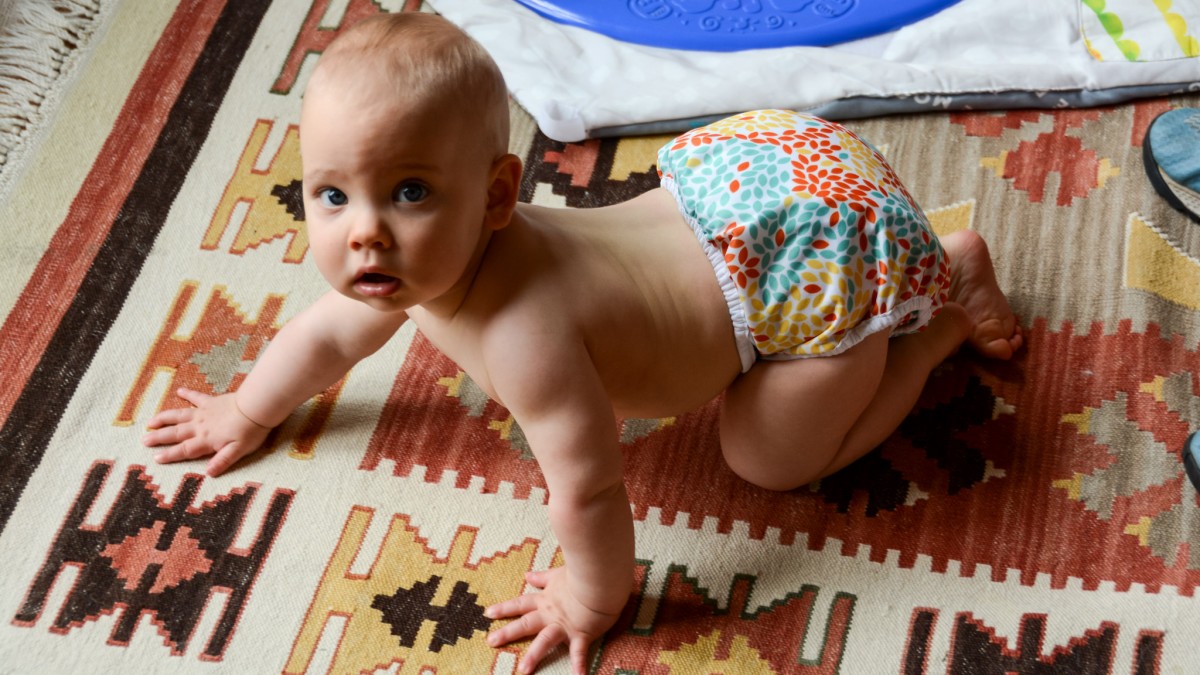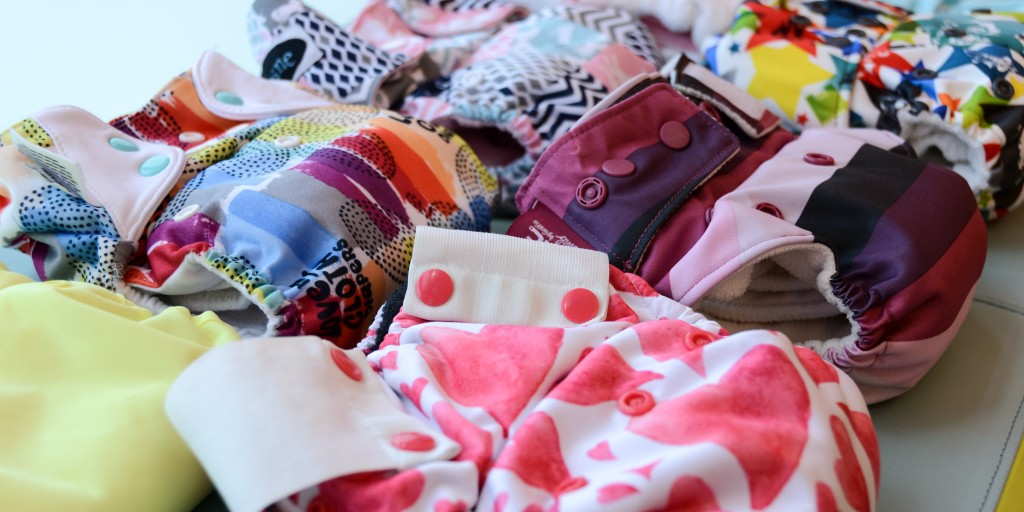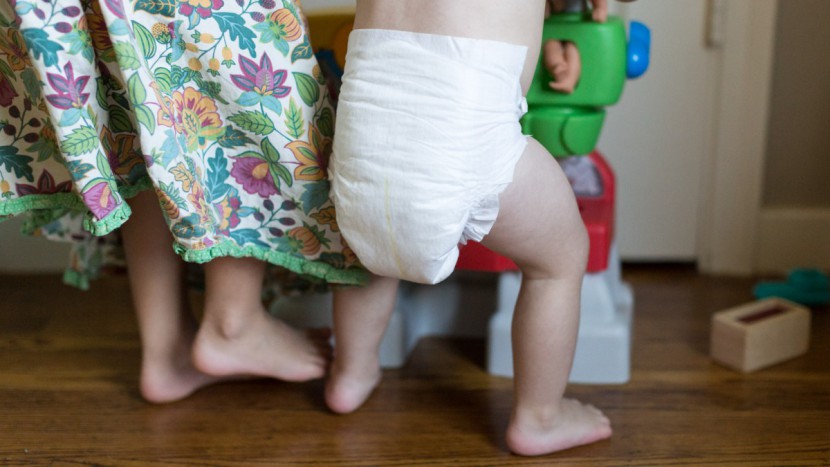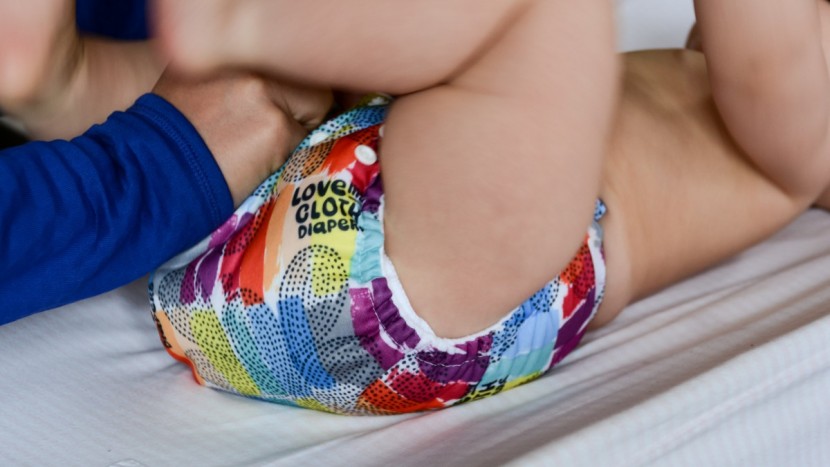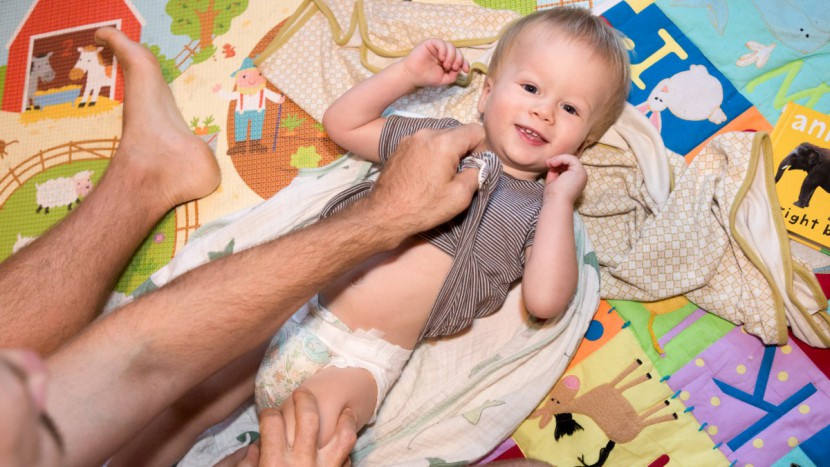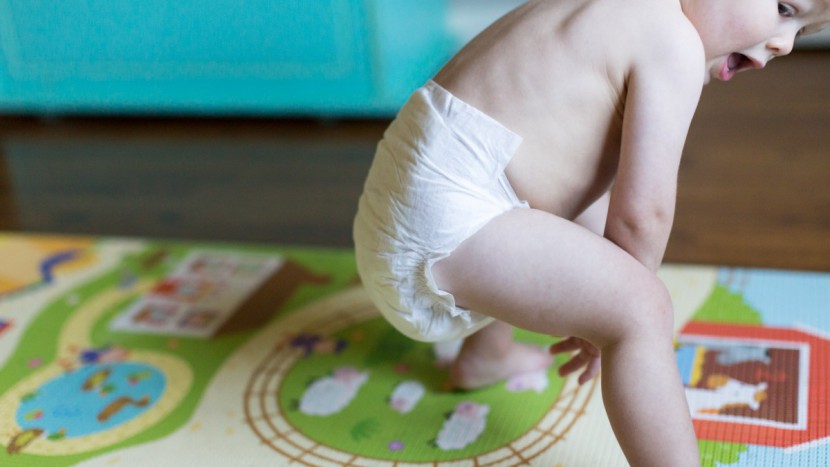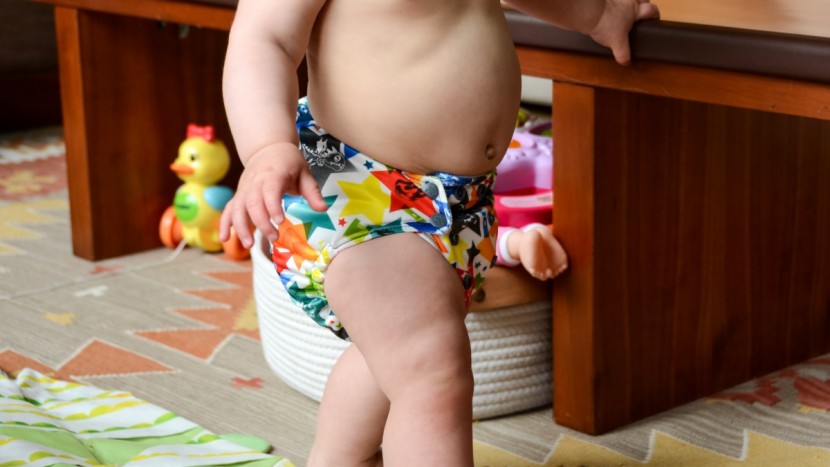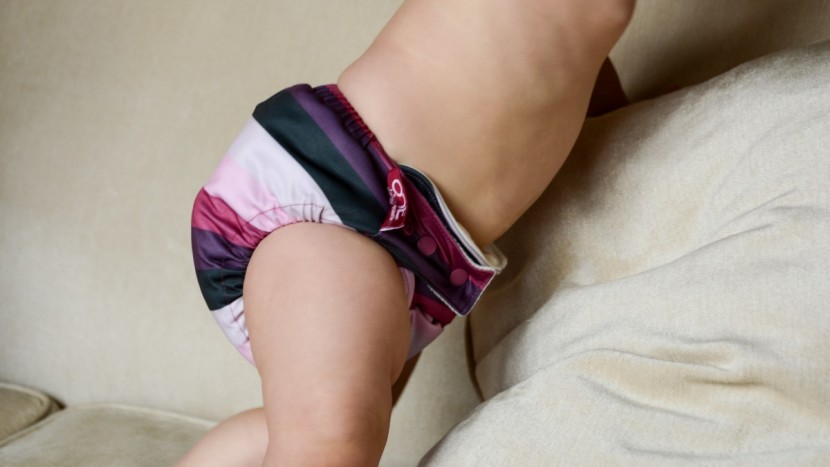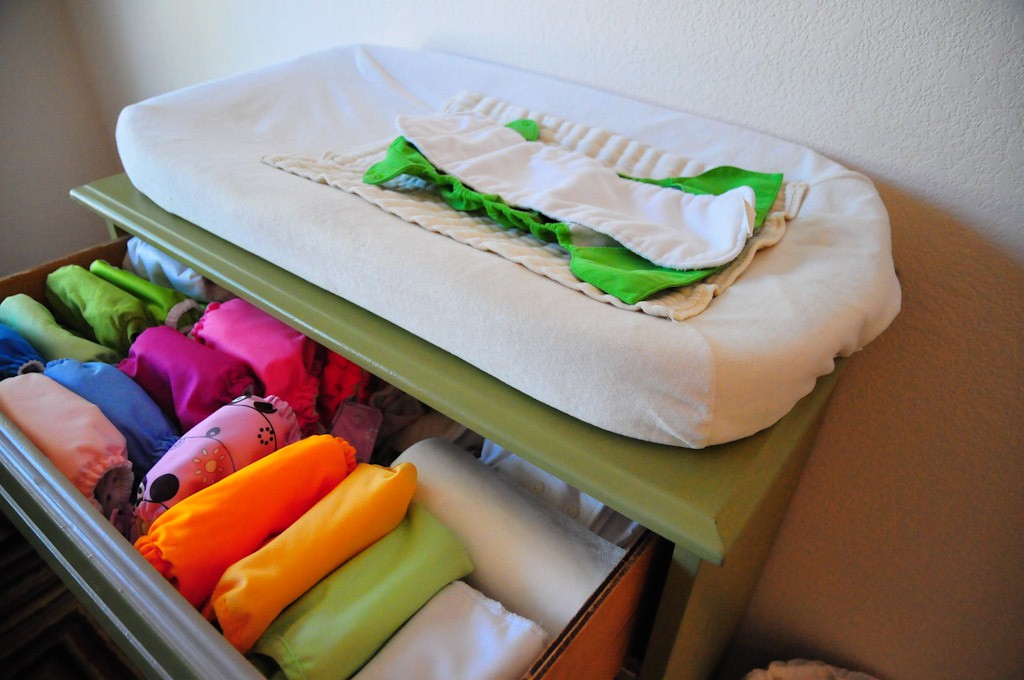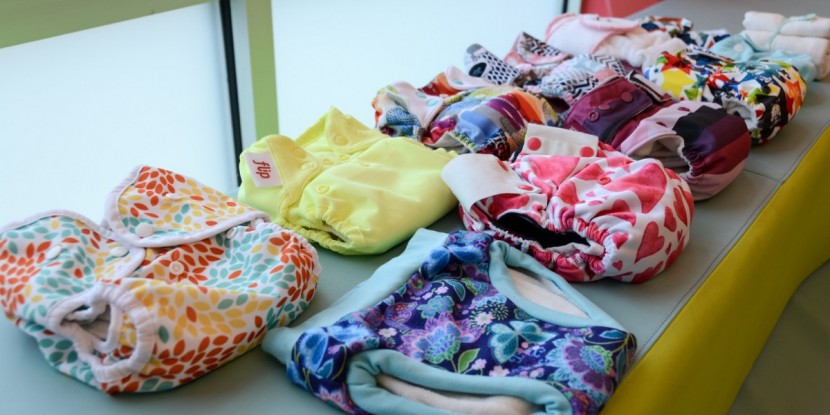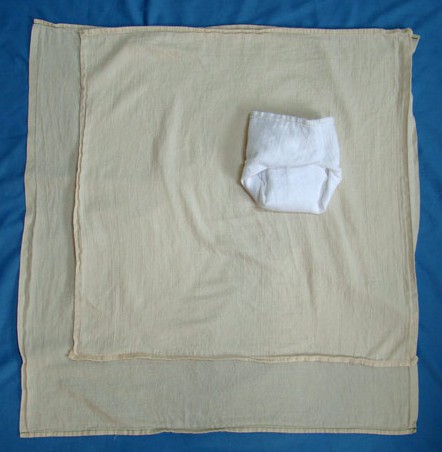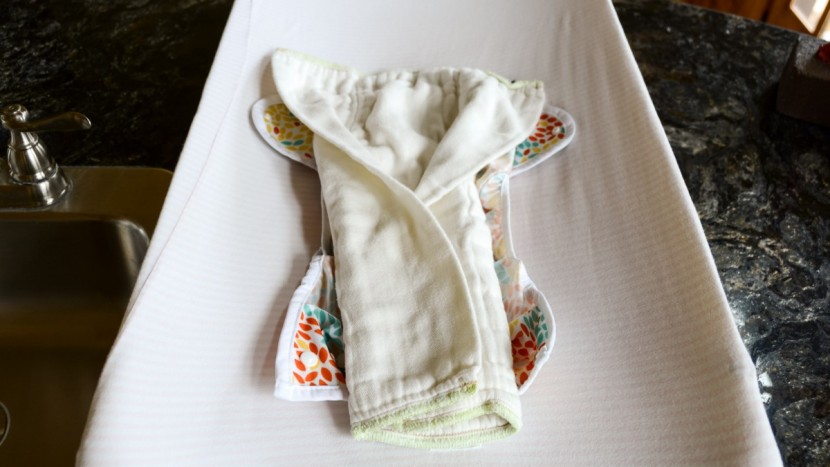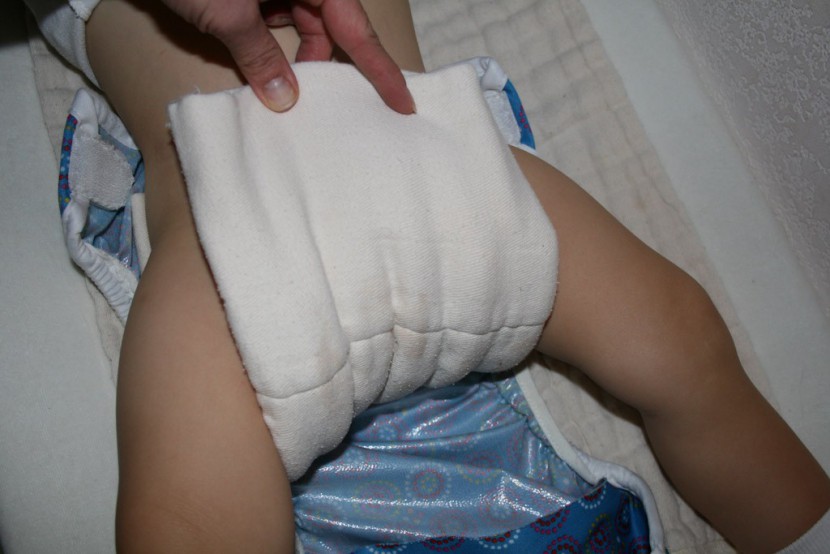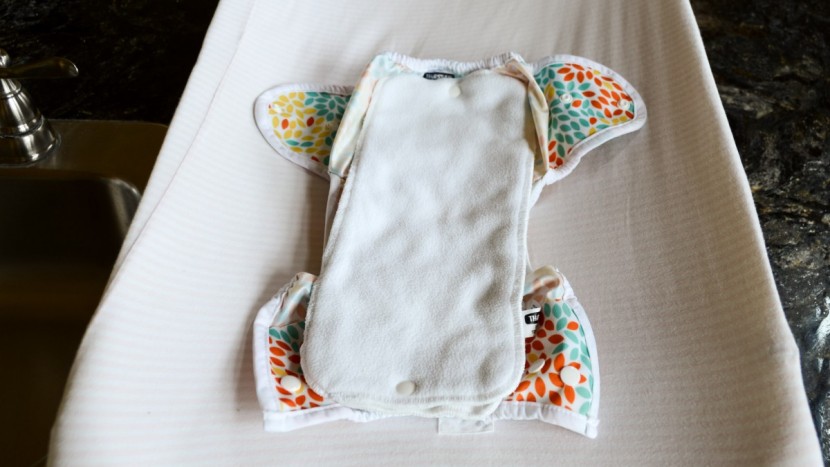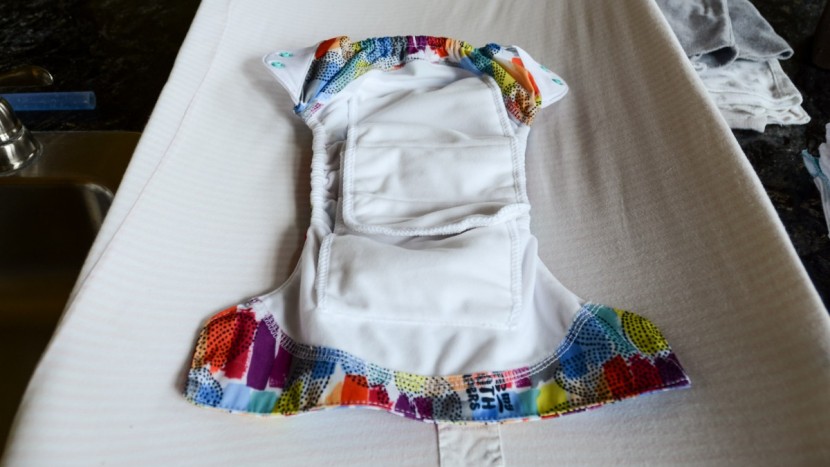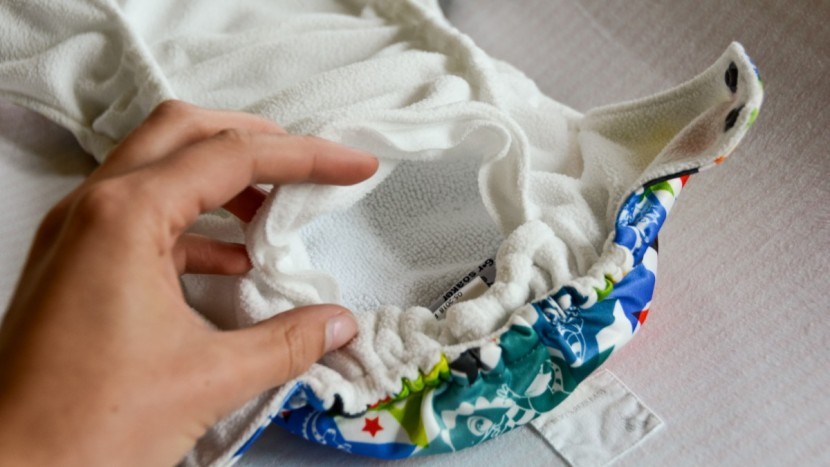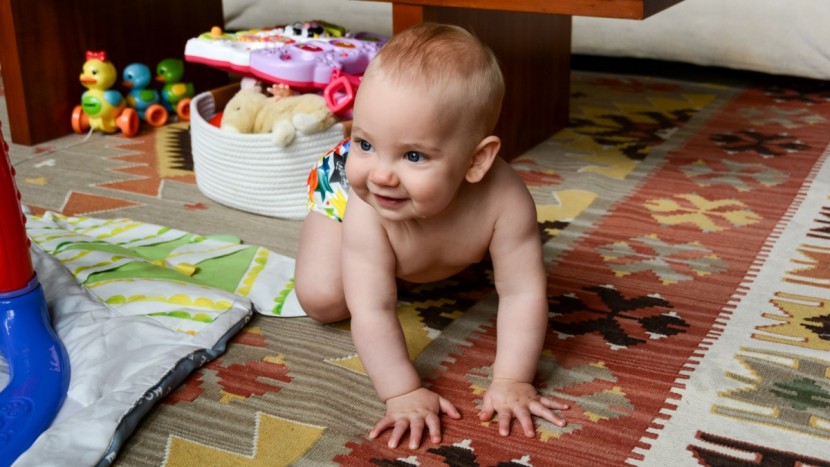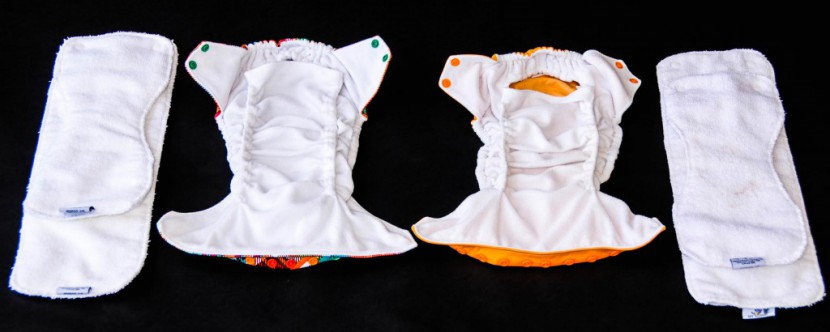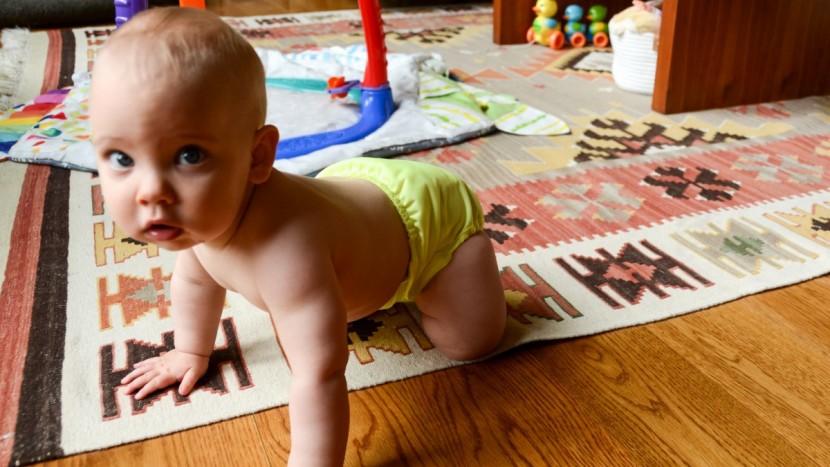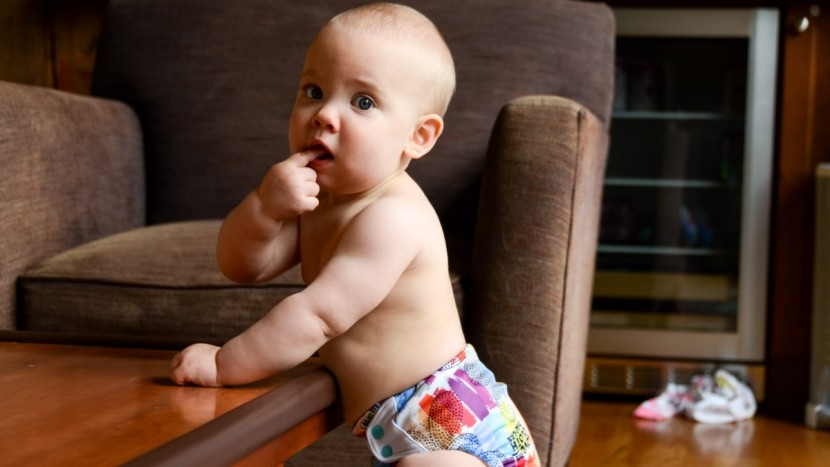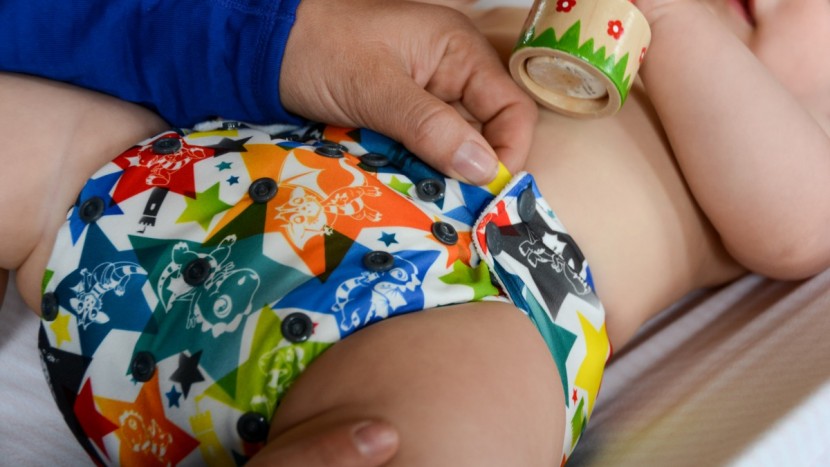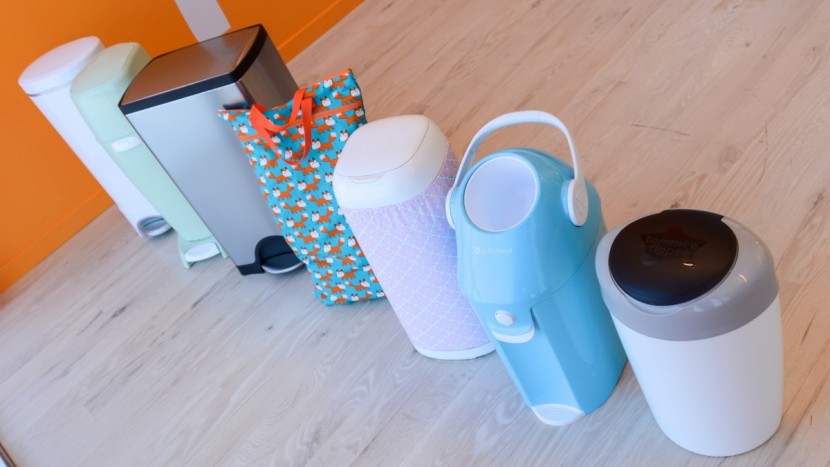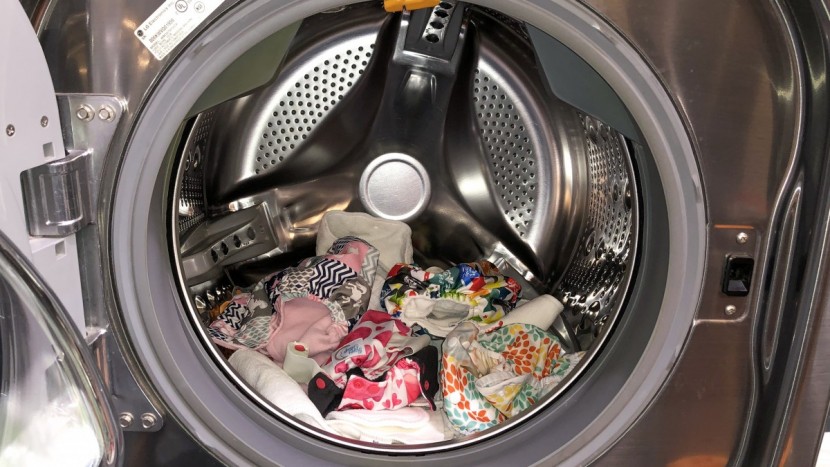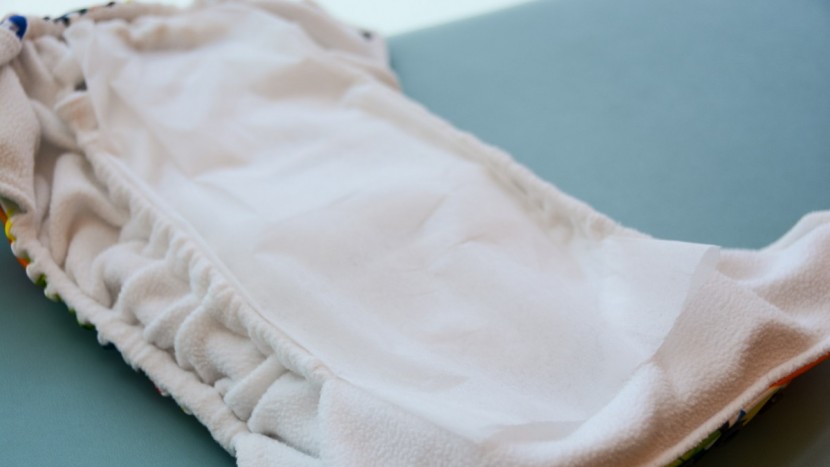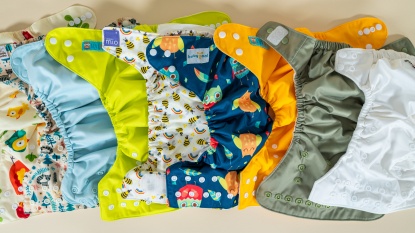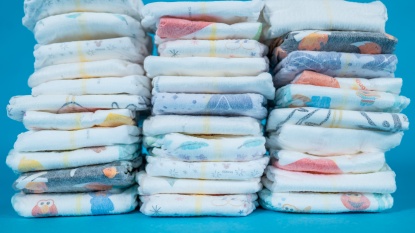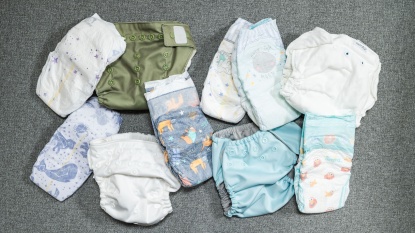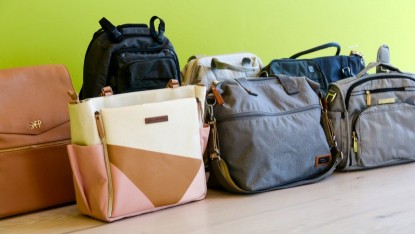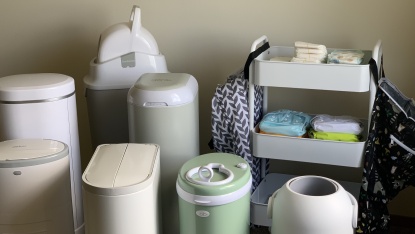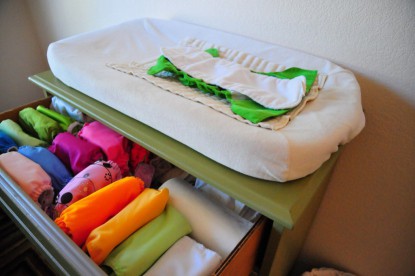After putting the top-ranked cloth diapers to the test and testing populardisposable diapers, we learned a lot about the differences between cloth and disposables and the best diapers of each category. With this information in hand, we'd like to share what we discovered and attempt to answer the daunting question of cloth vs. disposable diapers. We took into account factors such as eco-impact, baby health, performance, and cost when testing each brand and brought them together in this article so you can get a big-picture comparison. For those who think they want to try cloth diapering, we go one step further by including a detailed explanation of different systems, how to get started, and what it really means to go exclusively cloth. To tackle the intimidating task of laundering your diapers, we have a companion article on cloth diapers laundry tips and tricks that will help to simplify and streamline your diapering routine.
Cloth vs. Disposables
Cost Comparison
Most babies use an average of 6,000 diapers in their lifetime, and based on that, we have calculated lifetime cost estimates for each diaper in our reviews. If you take that information and compare cloth solutions to some of the most popular disposable alternatives, cloth has a clear advantage. The Kirkland Signature Supreme is a budget-friendly option that has an estimated lifetime cost of $1200, while the Flip with Stay Dry Insert, a cost-effective cloth diaper, has an estimated lifetime cost of $300. At face value, that is a savings of $900 for cloth! However, a more fiscally prudent analysis is less dramatic. There are some optional expenses related to cloth diapering you will probably embrace. Below is a breakdown of the costs and savings of using cloth.
- Machine wash and dry — Energy usage is an unavoidable added expense that comes with cloth diapering. According to a study done in the UK titled Environmental Agency analysis estimate, average US energy usage for washing and drying cloth diapers is about 400 kWh. This is over the entire course of a child's diapering lifetime — Add $50
- Cloth wipes — If you already signed up for laundering cloth, reusable wipes are an easy next step that will seamlessly integrate into your washing routine. A full lifetime supply of quality cloth wipes will cost you about $45 (we recommend at least 48 wipes). In comparison, disposable wipes will cost about $0.02-0.04 each, and you'll use 1-4 per change, netting about $360 over each child's diapering years. — Save $315
- Flushable liners — Flushable liners will change your life. A flushable liner will trap most of the poo, making it easy to drop in the toilet. Flushing the poo is better for the environment and a massive simplification in your laundry routine. At about $0.07 per liner, over the expected 6,000 diaper changes, the total is $420. Our favorites are the OsoCozy Flushable Diaper Liners which cost about $8 for a roll of 100. While it is a hefty added cost, we think it is worth it! We're talking about an average of $9-10/month over 3+ years of diaper changes to make poo management way simpler. — Add $420
- Diaper pail — We recommend the convenience of a diaper pail for cloth and disposable alike. With disposable, however, the costs are often higher due to pails using proprietary disposable liners. We estimated the lifetime cost of the Munchkin Step at over $200, most of it to the purchase of the disposable liners. In comparison, you can throw your cloth pail liner bag in the wash with the diapers and use it again. The cost of a quality pail with two washable cloth pail liners is $100 or less. — Save over $100
- Cloth Laundry Detergent — Your mileage will vary here depending on your washing machine, baby detergent that works for cloth diapers, and your tap water hardness. Averaging $17 and 45-90 loads per package, the cost of a quality detergent like Rockin Green will be somewhere between $200-400 over the course of your baby's diapering years. If you have a High-Efficiency washing machine or soft water from the tap, you will need less detergent and may be able to cut your cost in half to about $100 to $200. — Add $300
- Cloth Accessories — A little bit of this, and a little bit of that, many cloth accessories can be considered an optional expense. No matter how compelling the economic and environmental incentives of cloth, most people are held back by the fear of it being too much work, so we feel that a few cloth accessories are worth the investment if they can simplify the process. For example, a splatter shield and cloth diaper sprayer combo can undoubtedly be considered an optional convenience. However, the ability to spray off any remaining poo right there at the toilet may very well be worth it regarding your sanity. A drying rack is another convenient accessory, that will cut your energy usage and help cloth diapers maintain their absorbency. — Add $50
Cost Savings
In the end, your expenses are going to depend on which diaper you use and how much value you place on convenience. Both cloth and disposables come in a wide price range, and the lifetime costs of both flavors vary considerably. If you tally up both savings and expenses for everything we recommend using, you'll need to add $275 to our estimated lifetime cost of any cloth brand. With this addition, you will have a fair number to compare with disposables.
Here are a couple of examples of the fully-loaded comparison costs:
- Using a budget-friendly cloth option, like the Flip with Stay Dry Insert, will cost $575 in total and save you $685 over Kirkland Signature Supreme, a budget-friendly disposable.
- Using a higher-quality cloth option, like the Rumparooz Pocket, will cost $899 and save you $1,321 over using Eco by Naty, a higher-quality disposable diaper.
Baby-Health
All the disposable diapers we tested, including green diapers, use Super Absorbent Polymer (SAP). This petroleum-based product is what gives them a high capacity for absorbency in such a slim profile. They often include other chemicals and materials of concern, such as perfumes and dyes as well. If the idea of placing your baby's skin next to a petrochemical (SAP) 24 hours a day concerns you, then cloth is the way to go. It is much easier to find cloth solutions that are both eco-healthy and effective. We found the Stay-Dry cloth inserts to perform dramatically better in absorbency tests than the natural cotton or hemp alternatives, but they are usually polyester and are also petroleum-based. Despite this, we are comfortable with polyester fleece since the performance is so much better. But, it is something to keep in mind for those trying to avoid petroleum-based products in general. Then you may want to choose a natural fiber option such as the Sustainablebabyish Snapless Multi Fitted.
Eco-Health
The environmental case for cloth comes down to a few things: the production, the poo, and the garbage. Disposable diapers do not shine in any of these areas, and little can be done to improve their overall standing.
The Straight Poop
Let's talk about the disposal of disposable diapers and start with the nasty topic of poo. Your baby will make a lot of it. If you diaper the way most people do, you wrap up that poo in the diaper, reattach the Velcro-like closure, and drop it in the diaper pail. This method makes you inadvertently in violation of the law. It is illegal in most regions of the US to put human feces in the landfill because it is a bio-hazard that could potentially pollute groundwater systems. So the yucky fact of having to clean out your cloth diapers? You really should be doing that with any diaper, even disposables.
A typical child will go through 6,000 diapers, and that translates into a mountain of diapers going into the trash. The EPA estimates that 20 billion disposables end up in US landfills each year. To make matters worse, even claimed biodegradable disposables don't break down in landfills due to the lack of oxygen and water. When a green diaper company says that its product is biodegradable or compostable, we feel it is highly deceptive. In reality, the green diapers don't break down in the landfill and are no better than any other diaper in that aspect.
To that end, the FTC recently filed charges against the company that makes gDiapers for misleading claims about the disposal of their products. Bottom line: if you are using disposables, you need to face the reality that you will contribute approximately 6,000 diapers to the landfill. These diapers are going to be there for longer than your lifetime, and many of them will carry a bio-hazard load of human feces.
Greenhouse Gas Analysis
The other way to view the environmental impact of a diaper is by looking at a greenhouse gas analysis. Regarding carbon-footprint, disposables and cloth are surprisingly similar. A comprehensive greenhouse gas analysis by the UK Environmental Agency was done in 2008 and took into account the greenhouse gas emissions from disposables in landfills, as well as the full carbon footprint of both cloth and disposable. The conclusion was that reusable diapers did not have a significantly lower carbon footprint than disposables assuming the use of a machine washer and dryer. However, depending on your laundering habits, this does not have to be true for you. If you line dry and re-use cloth on a second child, then the carbon footprint is 40% smaller than disposables.
We accept the carbon-footprint conclusion of the UK Environmental agency as sound, but we think the swing vote is the poo and garbage involved with disposables. The UK analysis ignored both of these factors except in regards to the greenhouse gas emissions they produced. Frankly, we don't think it is prudent only to count the impact of gas emissions of the 20 billion diapers put into US landfills each year. That mountain of diaper garbage will take 100-500 years to decompose. We think a lot of parents will feel better about not putting their child's 6,000 diapers and poop in their local landfill.
Disposable Production and Dioxins
Another thing to consider is the production process of disposables. Traditionally, chlorine gas is used while processing the wood pulp found in the core of the diaper. This practice creates toxic substances known as dioxins.
The Environmental Protection Agency has identified dioxins as a likely human carcinogen. Also, based on animal research, dioxins are believed to cause reproductive and developmental issues, damage to the immune system, may interfere with hormones, and cause cancer. The impact of dioxin exposure could be even worse on a baby's immature and developing systems.
While many parents are concerned about the absorption of dioxins from baby wearing disposable diapers, that may not be your biggest worry. In our research, it is the creation of dioxins as a byproduct of the diaper that is the real problem. The dioxins that result from bleaching the pulp have a significant and lasting impact on the environment. Once created, dioxins take a long time to break down and accumulate over time. Humans are then exposed to them in several ways, but primarily through the food supply. While still harmful to your baby, dioxins are unlikely to release from fibers themselves, and the amount of exposure from diapers is limited.
To avoid producing this chemical, manufacturers are moving away from the traditional bleaching process. Instead, they are opting to use either Elemental Chlorine-Free (ECF) or Totally Chlorine-Free (TCF) wood pulp processing. EFC uses a kind of chlorine that creates fewer dioxins than chlorine processing (trace amounts) while TCF is free of chlorine (no creation of dioxins). Introducing fewer dioxins into the environment will, over time, result in fewer dioxins in our food supply and therefore, lowers baby's overall dioxin exposure. TCF is our production method of choice for disposable diapers, but cannot always be found. The good news is that cloth diaper production does not create dioxins, adding another eco-point to team cloth.
Diapers as a Fashion Statement
The range of color and pattern options available in cloth brands transforms diapers from a functional necessity to a fashion opportunity. Modern cloth systems come in such a wide range of fashionista-friendly colors and styles that you can consider them clothing. This diversity is not present in disposables, and it is most common to cover the diaper with shorts or pants. For all practical purposes, your baby can wear cloth diapers as short pants, and they look so darn cute!
Bottom Line
The case for cloth versus disposables on the metrics of cost, health, environmental impact, and aesthetics is refreshingly simple and compelling:
- It saves you money $$$
- It's healthier for your baby
- Diapering with cloth is better for the environment
- Cloth gives you options for overwhelming cuteness that disposables can't match
So, if the cost, health, and environmental arguments for cloth are so compelling, why doesn't everyone use cloth?
The answer is that many people fear that cloth is just going to be too hard. And those fears have some basis in truth: even the best modern cloth systems are a bit more work than diapering with disposables. Most of the extra work goes into the laundry that you must do every 2-3 days rather than dumping your baby's dirty diapers into the landfill.
About 9 of 10 families in the US today rely on disposable diapers. Many of them considered using cloth but backed off before they even tried it due to anxiety that it might be too hard and confusion about how to get started. It seems daunting.
We are going to do our best to alleviate that fear with a clear step-by-step explanation of how to use cloth. Present-day cloth systems have evolved enormously, and a modern approach can make cloth pretty simple and straightforward. One of the best ways to address the fear is by taking reusable diapers for a test drive.
Cloth 101
So you're still with us! That means you're deep down the rabbit hole of sustainable diapering and want to know more. In this next section, we'll give you an overview of the most popular cloth diapering systems and the pros and cons of each. Of course, if you find yourself torn between two styles, you don't need to settle for just one system or brand. It is common for parents to have a few different types of diapers to use in different situations, such as nighttime, daytime, and on-the-go use.
Another reason to try different brands is fit, which is key to preventing leaks. Our favorite cloth systems are one-size-fits-all, which, in theory, eliminates the need to try on different diapers. But, babies come in lots of shapes and sizes. What works great for one baby may not work as well for yours. Similarly, what works at three months may not work as well at 24 months. In the pursuit of fit more than anything else, it may make sense to try a handful of options before you commit to one cloth system. That said, we found the top-rated one-size systems such as the Flip and Rumparooz Pocket did deliver on the promise of a fantastic universal fit. In our tests on different size and age babies, they both worked well within their stated age/weight compatibility range.
Types of Cloth Systems
Modern cloth diapers are available in a variety of systems that attempt to make the process simpler. Ironically, the mind-boggling range of options can make the decision process much more confusing and may prevent many people from trying cloth at all. Where do you even start? There are strong advocates for each cloth diapering system and with loads of competing information available on the web, it can be tough for a novice to decide where to begin. Below, we'll give you the lay of the land so when your cloth-manic friend comes at you with terms like “all-in-one” or “pocket diaper” you can feel like you're in the know.
All-in-Two (AI2): Cover & Insert
The so-called “All-in-Two” (AI2) diapers are the classic cloth diaper system; the kind that was the standard in the US in the 1950s. These are composed of two separate pieces: a waterproof cover and an absorbent cloth insert. As a rule of thumb, each cover can be paired with any insert of your choice to create a diaper combination that works best for you. There are endless possibilities here for those who want to experiment.
Flats
Flats are the original AI2 system. It is something your great-great-grandmother may have used to diaper, and is still alive and well in the diaper world. A flat is a large square piece of fabric that is only a single layer thick and using a flat requires lots of folding and manipulating to get it onto baby just right. There is a definite learning curve to this style of diapering, but it has a very dedicated following because it is an effective and very affordable method. From our point of view, flats are a nostalgic throwback, and well on their way to becoming archaic. Modern cloth systems offer better performance and are so much easier to use that the minimal cost advantage of using flats is simply not worth it. We did not review flats in our testing round-up and do not consider them to be top contenders.
Prefolds — Rolling it Old School
A prefold is the upgraded version of a flat. This approach was invented in 1950 and became all the rage for the next decade. When you see an old picture of a 1950's mom fastening a cloth diaper with safety pins, you're looking at a prefold. The term refers to a rectangular piece of fabric (a flat), folded to be several layers deep and sewn at the edges. Most prefolds have three parallel sections with the center one made to be thicker than the outer parts. It still requires folding, albeit a much less complicated process than flast, and a waterproof cover. Different folding techniques ensure that you get the most absorbency in the area where you need it.
Today's use of prefolds is only slightly different than that classic 1950s approach in that no one is using safety pins any more. Instead, contemporary covers do the job of holding the diaper in the right place. However, if you have an extra wiggly baby, you may want something more to keep the prefold together. Thankfully, sharp “safety” pins are no longer necessary. Newer, and more practical options such as the Snappi are available. A Snappi is a pinless, T-shaped, stretchable diaper fastener with grips at each end.
Like flats, cost is the primary motivator to use prefolds. However, in our cost analysis, we discovered that the Flip with Stay Dry Insert is a very competitively priced option. We think it is a better performing diaper overall; it will give you dramatically better results in the critical areas of absorbency, comfort, and ease-of-use. At the end of our comparison testing, we frankly didn't feel that the prefold approach is compelling. It's more work than modern systems and the marginal cost savings is not enough for us to justify going with a sub-optimal method.
Fitteds
A fitted is a type of insert that is already shaped to fit baby. It has elastic gussets around the legs and often features a snap or Velcro-like closure around the waist. A fitted can be secured to create a very snug fit without all the folding and maneuvering. As an AI2 style, you will need combine a fitted diaper with a waterproof cover. If you notice that other inserts are becoming bunched or are slipping out of place within the cover, then a fitted insert may be an ideal solution. Some fitteds also offer greater absorbency than other styles of cloth diapers so might be good for overnight use. In our tests, the Sustainablebabyish Snapless Multi Fitted performed very well when paired with a reusable microfleece liner.
Hybrids
The next type of All-in-Two diaper system is the hybrid. Straightforward and easy to use, the main advantage of hybrid systems is that they incorporate a better design approach of integrated covers and custom-fitted inserts. This combo outperforms the old-school cover & pre-fold method by far. Most brands offer a variety of insert options such as organic, synthetic, and disposable. The best of the hybrids offer thoughtful multi-layer combinations of natural and synthetic insert materials. We prefer styles that have a wicking layer next to baby's skin to keep moisture away and help prevent rashes. On the underside, multiple layers of more absorbent material lock-up moisture in the core of the diaper.
Unlike a pre-fold, hybrid inserts are custom shaped and sewn to fit their cover like a glove, no folding required. You lay the insert directly into the cover, and it's ready to go. If the outside wrap isn't soiled, it can easily be reused by removing the wet insert and replacing it with a clean, dry one. The ability to reuse covers reduces laundry and is terrific for families who often find themselves on-the-go. While you can mix-and-match inserts from other brands with a hybrid cover, the fit may not be as ideal as the manufacturer's proprietary inserts.
All-In-One (AIO) Diapers
We like AIOs for their ease-of-use, but not enough to recommend that you build your entire stash from this kind of diaper.
Just as it sounds, this is a one-piece diaper with the cover and insert sewn together, so there is no assembly required. These are an excellent choice for those who desire a diaper that is most similar to a disposable. Perfect for use at daycare, with grandparents, or for those expressing some hesitation about cloth. There's no sorting, stuffing, folding, or matching involved. Just put the diaper on, and you're ready to go! The downside? AIOs create more laundry because you need to wash the combined cover and insert after every single change, unlike AI2s, which you launder the inserts every time, but reuse the cover. Also, many brands of AIO require longer drying times because the layers are unable to be separated. We prefer Hybrids over AIOs. However, you may be a fan if one-pieced simplicity strikes a chord with you.
Pocket Diapers
Similar to AI2s, pocket diapers have two parts: a cover and an insert. An opening on one side of the cover allows you to stuff the insert between the lining and the shell. The pocket acts as a wicking layer next to baby's skin, and it can hold one or more inserts to serve as the absorbent core. Our favorite pocket diapers have very soft liners and thus are very comfortable for baby.
Pockets are nice because they have a built in barrier between baby and the absorbent material. The pocket material acts as a wicking layer so moisture isn't sitting against the baby's skin for long. We also like that you can customize the absorbency to suit baby's needs by choosing different numbers of inserts. For example, doubling up is a good strategy for nighttime when extra wetting may occur. Pockets also function exceptionally well if a baby is a heavy wetter who needs additional absorbency or is sensitive to feeling moisture against the skin.
The main drawback to a pocket system is that the diaper requires you to stuff the insert in the pocket before each change and adds an extra step in the preparation of the diaper before wear. Some pocket diapers are more accessible than others, depending on the pocket opening size. Keep in mind that the insert also has to be removed from the pocket before laundering, which can sometimes be unpleasant. As with an AIO, there is more laundry with pocket diapers. The entire pocket/cover combination will go into your laundry bag after every diaper change, whereas a hybrid might merely require washing the insert. Because of this, you will need more cover/pocket diapers on-hand, which then increases your lifetime costs.
We think that pockets are the best way to go in terms of performance, and we like the Rumparooz Pocket. That said, hybrids are a very close second and tend to be less expensive. It's easier to prepare the diapers for wear, and you can switch out the inserts during changes and reuse the cover. If you are looking for some more general info, above is a handy video from Fluff Love University that describes the different types of cloth diapers as well as useful accessories to ensure successful cloth diapering.
Dealing with a Poopy Diaper
Assuming you take our recommendation and decide to use flushable liners, then you'll find disposing of the poop to be very simple: drop everything in the toilet and flush. In most cases, the liner will retain the poop well, and you won't need to do anything else. If there is some poop on the diaper or insert, then wipe it off with some toilet paper. Your baby's poo will go in the toilet where it belongs and then head toward a municipal water treatment system that is designed to handle it properly.
If you are breastfeeding, the process is even more straightforward up until your baby starts eating solids. You can just put the poopy diaper from an infant that is exclusively breastfeeding directly into the wash (the breastfeeding poop will disintegrate and wash away). The Rumparooz site has some useful tips on handling the poop.
Laundry
Each diaper manufacturer has its own washing instructions that will keep your diapers performing to their best ability. However, you will generally want to do laundry every 2-3 days, and store your dirty diapers in a dry pail or wet bag with some air circulation to prevent mold and ammonia buildup. Wash the dirty diaper following the proper laundry routine and line dry when possible to make sure you keep the diaper working in top condition.
How to Test Drive Cloth Diapers
The easiest way to test drive cloth is to start with disposables. We know, it sounds crazy, but trust us. If you want to purchase one or two cloth diapers without having to commit to building an entire stash, it is smart to have a few trusty disposables on hand. You might also consider waiting until baby is in size one disposables to buy any cloth diapers at all. Infants outgrow their newborn-sized garments quickly, and many one-size cloth systems may not fit well until your baby is a bit bigger.
We recommend trying one or two of the best cloth diapering systems for your test drive. This approach is relatively inexpensive, but it will still give you a realistic sense of what it would be like to use cloth. Having reviewed numerous top-notch cloth systems, we can confidently recommend two of our favorite products to consider for a test drive.
Rumparooz Pocket
A great starting product is the Rumparooz Pocket. This diaper is one of the easiest-to-use cloth systems we have encountered. It is so soft and well-made that it quickly became a favorite. It is a one size fits all diaper, so you don't need to worry about sizing, and includes everything you need in a single purchase. When you get it, you will need to wash it before the first use. Carefully follow the laundering instructions on the Kanga-Care website for the best long-term results.
You'll find using the Rumparooz to be a lot like a disposable. The difference is that you'll stuff an absorbent insert into the pocket of the diaper, and place a flushable liner on the top (between baby and the diaper). Outside of that, your diaper changes will be pretty much the same. It is a one-size diaper and the rise and waist snaps must be adjusted properly to fit your baby.
Read Review: Rumparooz Pocket
Flip with Stay Dry Insert
The other cloth system that you might want to test drive is the Flip with Stay Dry Insert. Like the Rumparooz, we loved the Flip and found it very easy to use. It is one-size-fits-all, so you don't need to worry about sizing. To start, you can purchase a single Flip cover and a few Stay-Dry Inserts to go with it. That way you can rotate while reusing the cover multiple times.
Laundry care instructions for the Flip are different from the Rumparooz, so be sure to take a look at Flip specific washing instructions. As with any cloth diaper, you must wash the Flip cover and stay-dry liner once before the first use. We recommend getting a cloth-specific laundry detergent such as one of these. Cotton Babies (the makers of the Flip) has also written how-to instructions detailing how to use the insert and cover combo.
Read Review: Flip with Stay Dry Insert
Further Deciding Factors
The following are topics to consider when making your selection. You should take these into account and decide which features are most important to you. As a whole, they will help create clarity in your purchasing decision.
How Many Will I Need to Get Started?
After you test drive one or more cloth systems, and you feel like you've found a sustainable routine, pick the one you like and buy a full supply. In general, you will need a stash of about 30 diapers to last for the duration from infancy to potty training, and we recommend 36 diapers for optimal convenience. Don't get less than a minimum of 24 or you'll risk finding yourself short just when you need it.
Purchasing the necessities can be accomplished economically with one-size (OS) systems. Some brands, like Thirsties, come in two sizes. For these you will need about 30 for each stage, making sized diapers a bit more pricey overall.
If you are determined to use cloth from birth, you may need a smaller, newborn set, like the Thirsties Newborn All in One to work with until baby fits into OS or Size 1 diaper. If you are looking for a cheaper route for the early days, many families use a green disposable diaper or prefold/cover combo for the newborn phase. This stage typically lasts only through the first month.
Nighttime Diapering and Heavy Wetters
Cloth diapers have an advantage over disposables for overnight or heavy wetters since you can use extra absorbent doublers for these situations. Pocket diapers let you stuff several inserts for overnight, while AI2s allow you to layer as much absorbency as you feel necessary. For AIO's, we especially like the GroVia O.N.E. for its absorbency superpowers.
It may take some investigative work to find the right solution for diapering at night or even during the daytime if you have a heavy wetter on your hands. We found some advice from the blog Thinking About Cloth Diapers to be particularly helpful when it came to these issues.
Eco-Health Considerations
For some parents, eco-health is their number one priority, and deciding to go with cloth is a natural step. All of the cloth systems we tested offer significant eco-health advantages over disposable diapers. Even the greenest disposable options typically include synthetic chemicals that cause many people concern.
The more subtle eco-dilemma comes when trying to decide whether to go with natural or synthetic fibers. Some manufacturers strive to use only natural fibers such as cotton, hemp, or bamboo. Diapers made with synthetic materials usually contain polyester in the microfleece and microfiber fabric. There are pros and cons to both.
Natural Fabrics
Many parents prefer natural fabrics touching their baby's skin. Natural, organic fibers feel safer to use for baby and are better to put back into the environment. They are also less likely to cause the occasional allergic reaction or irritation that sometimes comes with polyester. Some parents consider it a benefit for baby to feel when they are wet, arguing that it makes them more in tune with bodily functions and easier to potty train later on.
Synthetic Fabrics
When it comes down to it, both natural and synthetic fabrics hold large amounts of liquid, and both will work well in a diaper. The main advantage of polyester-derived material is wicking power. Keeping moisture away from the surface layer next to baby's skin can help prevent diaper rash and extend the time between changes.
If you are still stuck, then there are many options out there that allow you to combine fabrics to your liking. With many companies offering additional organic inserts, as well as reusable microfleece liners, you can mix and match to your heart's content.
Waterproofing
The exterior of all cloth diapers requires a waterproof barrier to keep moisture inside. The natural option is to use lanolized wool but more commonly you will find either PUL or TPU laminates. There are only a few companies that utilize TPU in their waterproofing, but this is a healthier option as it is biodegradable. TPU uses heat bonding rather than chemical bonding for lamination. If eco-health is important to you, be sure to check the materials list to find out which kind of specific diapers use.
Closure Type
For most modern cloth systems, you will need to decide between snaps or Velcro-like (also referred to as hook-and-loop) closures. There are pros and cons to each, but our recommendation is simple and clear: go with snaps! They are more durable, and you will be thankful to have them when your baby rises to a toddler. We feel very strongly about this and did not include any diapers with hook-and-loop closures in our review.
Longevity
Snaps last through the long haul. Velcro-like closures tend to wear out faster, and if you forget to fasten them before washing, they stick to everything and create havoc in the laundry room! Hook-and-loop closures tend to get filled up with lint, and as a result, they lose their binding strength over time. While it seems like a Velcro-like closure will be more straightforward, we found that in the long run, snaps are much better for ease of use.
If you do go with a hook-and-loop closure, several companies offer options for when they wear out. Some provide replacement kits for the tabs (which involves ripping off old ones and sewing on new ones). Others have conversion programs where they will change your Velcro closures to snap ones.
Ease of Use
Snaps are harder for babies and toddlers to undo themselves. During infancy, this may not be as big of a deal, but as your baby gets older, they may become fascinated with undoing their diaper. Snaps can make it easier to prevent the resulting pee-pee or poopy mess.
Nonetheless, Velcro-like closures are more akin to putting on a disposable. Let's face it, matching up buttons on wriggly babies takes practice. Also, for those not accustomed to snaps, getting the correct fit with this type of closure can be more simplistic. So, a Velcro-like closure is something to consider if grandparents or other caregivers such as a daycare provider will be using the diapers as well. Frankly, we think that a small supply of quality green disposables will suffice for these situations. You'll be better off exclusively using snap closures for your cloth diapering.
What You Will Need
Beyond the actual diapers, there is a list of cloth paraphernalia that makes life a lot easier. Some of these things are must-haves, and others are nice-to-haves. We have taken the deep dive and feel confident in our ability to offer up quick insights and will let you know what our favorites are.
Dirty Laundry Storage
Back in the day, your grandmother might have used a “wet pail,” which is a bucket filled with a soaking solution like water and bleach, to sterilize the diapers. Now, most diaper manufacturers discourage the use of wet pails, and may very likely void your warranty if you use one. Today, cloth diapering parents store dirty diapers in a hard, dry pail with a reusable wet bag as a liner. It can be anything from a traditional trash can to a container made specifically for cloth diapers. The other option is a large soft wet bag that hangs from either a doorknob or a hook.
When it is time to do diaper laundry, you throw the bag in with the diapers to keep it clean. It's nice to have a second wet bag, so you have one ready to hold diapers while the other is in the wash. It is a good idea to have some source of airflow through the diaper pail or bag to help reduce bacteria and ammonia build up and mold. Laundering cloth diapers every two days instead of every three days will help these issues as well. Our favorite system is the combination of a Simple Human can with a Kanga Care Pail Liner. For travel, a small Kanga Care Cloth Diaper Wet Bag is convenient.
Cloth-Safe Laundry Detergent
It is essential that you use either a manufacturer recommended or cloth-specific laundry detergent for your cloth diapers. It will help them maintain maximum absorbency, prevent residue buildup, and lengthen their lifetime. Our favorite to date is Rockin Green Bare Naked Babies.
Cloth-Safe Diapering Cream
Never use traditional diaper rash creams or ointments with cloth, as most of them are impossible to get off the diapers. They cause staining and decrease absorbency. Using cloth lessens the likelihood of diaper rash anyways, but if it does happen, find a diaper cream that is made specifically for use with cloth. We like Earth Mama Organic Perineal Balm. You can also try a home remedy like olive oil, coconut oil, or cornstarch, all of which are safe to use with your diapers. If you are unable to get around using traditional diaper creams, place a liner on top of the diaper as a barrier to protect the surface.
Cloth Wipes
We love cloth wipes! Not only do they work much better than disposable wipes, but there's no waste, and they're not a lot of extra work. Our favorites are the GroVia Cloth Wipes. Wet them, fold them in half, and put them into a wipe warmer near the changing table, and they're ready when needed. After changes, throw them in the same pail with the diapers that are going to be washed. We recommend having at least 48 on hand.
Flushable Diaper Liners
These are optional, but we highly recommend using flushable diaper liners! A diaper liner is a super-thin sheet of fabric (much like a dryer sheet) that liquid can pass through, but solids cannot. You place it as the final layer between baby and the diaper to make post-change cleanup less cringey. No spraying, dunking, swishing, scraping, or shaking necessary. All that's involved is lifting the liner and solids off the diaper and dropping it in the toilet; the materials are flushable and biodegradable. The thought of clean up alone is enough for many to shy away from cloth diapers altogether, so we strongly urge you to use liners.
As with anything, it's not a perfect system all the time. Sometimes the poop does find its way off the liner, especially as your baby gets older and more mobile, but it really helps! We recommend Eco Sprout Eco-Bottom Liners, but before you go ordering away, there's no need to worry about this until your baby starts eating solid foods. Exclusively breastfed baby's poop is water-soluble, so there is no need to use liners at this stage. Throw the whole thing in the wash, and it will dissolve away; but once your baby moves on to solid foods or formula, their poop is going to change consistency. Using a liner is one way to make your life in the cloth diapering world a lot easier.
Sprayer
Many parents feel that when combined with a flushable liner, a sprayer reduces the yuck factor greatly. Typically hooked up to the plumbing of your toilet, its function is to clean off unmentionables before storing them in a pail. A sprayer is a necessity for those who wince at the thought of using toilet paper or a spatula-type device to remove stool. If this sounds like you, we recommend the Bumworks Cloth Diaper Toilet Sprayer Kit to get you through this diapering dilemma. Though not a necessity, the Spray Pal Splatter Shield is a nice companion to a sprayer, helping to keep nasties from sprinkling all over the place when rinsing your diapers.
Drying Rack or Line
Having a place to dry your diapers is necessary for those covers that can't go in the machine. If you have stains, putting a rack or line outside in the sun will help remove both stains and stink. We think this is a worthwhile investment as it will reduce energy usage and extend the life of your diapers. Plus, you can use it for other articles of clothing after you've passed the diaper stage.
Finding the Best Fit
When it really comes down to it, you are going to choose the system that will work best for your family. Though there is more of a learning curve to cloth diapering when compared to disposables, it is healthier for your baby and will be a more economical approach. If you are conscious about your washing routine, the environment benefits as well. Still, cloth is not for everyone, and we recommend testing the waters before you dive in.

